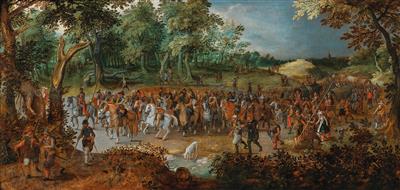Sebastiaen Vrancx

(Antwerp 1573–1647)
A procession of soldiers on horseback at the entrance of a forest,
oil on panel, 42 x 87 cm, framed
The present composition showing a troop of cavalry, accompanied by foot soldiers, their baggage train and camp followers processing along a road is a fine example of the type of varied narrative depiction of Flanders, its customs and citizens for which Sebastian Vrancx was so renowned. The artist himself was appointed captain of the Antwerp militia from 1626-1631(and so was portrayed by Anthony van Dyck with his sword prominently displayed). The current work, with its arresting attention to details such as the uniforms and posture of the well-drilled soldiers, from the troopers upright in their saddles to the pikemen and arquebusiers with their weapons carefully hoisted, recalls the meticulous depictions also undertaken by Vrancx of the costumes of burghers at fairs or villagers at kermesses. However, Vrancx’s experience of military command adds a degree of sincerity, and occasional grisly realism that is noteworthy.
In spite of the naturalistic attention to the landscape along with the belfry so typical of the Low Countries, there is some evidence in the present picture of Vrancx’s journey to Italy in the 1590s. The perspectival enhancement of colouring each horse differently is redolent of much earlier treatments of mounted skirmishes such as the works of Paolo Uccello and his followers. Scant evidence of Vrancx’s trip south of the Alps remains and his position as dean of Antwerps Confrérie van romanisten, of whom Van Dyck and Ruben were also members, for which a visit to Rome was a pre-cursor. Evidenced also by the animated figures, and humour of the present panel, is the sense of drama typical of a member of the Antwerp chamber of the rhetoric, Violieren, to whom Vrancx and his collaborators Frans Francken II and Jan Brueghel II also belonged. A letter of 1634, from Brueghel to his business partner in Seville, assured him that: ‘Vrancx has plenty to do but refuses to employ studio assistants, which means that work takes a long time. He does not allow copies to be put into circulation’ (see H. Gerson and E. H. ter Kuile, Art and Architecture in Belgium, 1600–1800, Harmondsworth 1960, p. 63, note 33).
Esperto: Damian Brenninkmeyer
 Damian Brenninkmeyer
Damian Brenninkmeyer
+43 1 515 60 403
old.masters@dorotheum.com
09.06.2020 - 16:00
- Prezzo realizzato: **
-
EUR 47.800,-
- Stima:
-
EUR 40.000,- a EUR 60.000,-
Sebastiaen Vrancx
(Antwerp 1573–1647)
A procession of soldiers on horseback at the entrance of a forest,
oil on panel, 42 x 87 cm, framed
The present composition showing a troop of cavalry, accompanied by foot soldiers, their baggage train and camp followers processing along a road is a fine example of the type of varied narrative depiction of Flanders, its customs and citizens for which Sebastian Vrancx was so renowned. The artist himself was appointed captain of the Antwerp militia from 1626-1631(and so was portrayed by Anthony van Dyck with his sword prominently displayed). The current work, with its arresting attention to details such as the uniforms and posture of the well-drilled soldiers, from the troopers upright in their saddles to the pikemen and arquebusiers with their weapons carefully hoisted, recalls the meticulous depictions also undertaken by Vrancx of the costumes of burghers at fairs or villagers at kermesses. However, Vrancx’s experience of military command adds a degree of sincerity, and occasional grisly realism that is noteworthy.
In spite of the naturalistic attention to the landscape along with the belfry so typical of the Low Countries, there is some evidence in the present picture of Vrancx’s journey to Italy in the 1590s. The perspectival enhancement of colouring each horse differently is redolent of much earlier treatments of mounted skirmishes such as the works of Paolo Uccello and his followers. Scant evidence of Vrancx’s trip south of the Alps remains and his position as dean of Antwerps Confrérie van romanisten, of whom Van Dyck and Ruben were also members, for which a visit to Rome was a pre-cursor. Evidenced also by the animated figures, and humour of the present panel, is the sense of drama typical of a member of the Antwerp chamber of the rhetoric, Violieren, to whom Vrancx and his collaborators Frans Francken II and Jan Brueghel II also belonged. A letter of 1634, from Brueghel to his business partner in Seville, assured him that: ‘Vrancx has plenty to do but refuses to employ studio assistants, which means that work takes a long time. He does not allow copies to be put into circulation’ (see H. Gerson and E. H. ter Kuile, Art and Architecture in Belgium, 1600–1800, Harmondsworth 1960, p. 63, note 33).
Esperto: Damian Brenninkmeyer
 Damian Brenninkmeyer
Damian Brenninkmeyer
+43 1 515 60 403
old.masters@dorotheum.com
|
Hotline dell'acquirente
lun-ven: 10.00 - 17.00
old.masters@dorotheum.at +43 1 515 60 403 |
| Asta: | Dipinti antichi |
| Tipo d'asta: | Asta in sala |
| Data: | 09.06.2020 - 16:00 |
| Luogo dell'asta: | Wien | Palais Dorotheum |
| Esposizione: | 02.06. - 09.06.2020 |
** Prezzo d’acquisto comprensivo dei diritti d’asta acquirente e IVA
Non è più possibile effettuare un ordine di acquisto su Internet. L'asta è in preparazione o è già stata eseguita.
